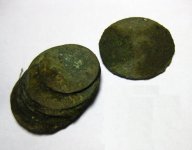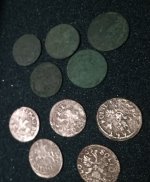Good afternoon.
I am engaged in creating collages on a historical subject and to me often get objects in a very deplorable state. I can not say that I'm a great specialist, but I already have some experience in cleaning metal objects.
Now I have a few copper coins that have stuck together into a single piece. I am ready to make a report on how to separate them into separate coins and clean them from the patina.
Just want to note that my cleaning methods are not academic - their goal is to quickly and effectively lead the coins to the state of pure metal. In this case, the metal is completely cleared of the patina. I use cheap and affordable methods - electrolysis and acids. If I need to return the patina, then I use the formulations containing sulfur.
Is it worth doing such a report or is this subject not interesting?
If the community finds the topic interesting - from Monday I will start to deal with these coins and ready to make a photo report.
I am engaged in creating collages on a historical subject and to me often get objects in a very deplorable state. I can not say that I'm a great specialist, but I already have some experience in cleaning metal objects.
Now I have a few copper coins that have stuck together into a single piece. I am ready to make a report on how to separate them into separate coins and clean them from the patina.
Just want to note that my cleaning methods are not academic - their goal is to quickly and effectively lead the coins to the state of pure metal. In this case, the metal is completely cleared of the patina. I use cheap and affordable methods - electrolysis and acids. If I need to return the patina, then I use the formulations containing sulfur.
Is it worth doing such a report or is this subject not interesting?
If the community finds the topic interesting - from Monday I will start to deal with these coins and ready to make a photo report.









